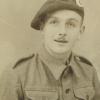As a cadet in the Cambridge University Officer Training Corps I applied for parachute training in lieu of summer camp. I was the eager student of the diminutive Sergeant Hurry, Royal Air Force, an inexhaustibly patient instructor in a school whose motto was: “Knowledge dispels Fear”.
In the army you don't pack your own parachute. I believe a woman packs it. It has to be done in a special way, so that as it is pulled out of its pack a series of ties are broken by the force of your falling body, until finally the canopy opens and arrests your descent.
They teach you to jump, descend and fall, to take off, fly and land. They tell you what happens if you don't do it properly. If you don't jump with enough determination, you are caught in the slipstream, and when the parachute opens the lift webs are all twisted. If you don't carry out the proper drills on the descent, you may not notice that your canopy hasn't opened properly, or that you are about to collide with another parachutist, or that you are oscillating beneath your parachute and may not be able to land safely. If you don't prepare for your landing, the wind may carry you too fast across the field, and your feet may not be correctly angled to take the impact as you hit the ground. In short: 'eels, arse, 'ead, ‘orspital!
The trouble is that descent from 1000 feet takes less than a minute, and to begin with it's such a strange experience that you may not get around to carrying out the drills at all. This may mean that your arrival on the ground is even more of a shock than you expected.
If you're a person of average sensitivity you will be frightened, so you have to rely on your defence mechanisms, and this is much easier than you might expect. The difficulty is that when they are being applied with full force they have a retarding effect upon your reactions. So you will be rather slow on the uptake at the most testing moments of the operation, particularly when you are carrying out your drills in the aeroplane and preparing for the jump. It is significant that at this stage you are responsible for checking the equipment of your fellows - and they yours. You have to keep control of yourself, and the desensitising that this entails detracts from the splendid drama of the moments when the red and green lights flash over the open door of the aeroplane.
If there are a large number of you, the aeroplane may have to make several approaches to the dropping zone. There are about five minutes to wait while it is lined up for another run , and this may happen several times in one operation. The more men there are in a stick, the more dramatic the scene becomes. But drama is not the intent; it is the result. Members of the stick have to go out of the door in very rapid succession to be sure of landing within the dropping zone, so the hesitation of one man can be a serious upset to the whole run . The dispatcher is not allowed to push him out, even at his own request, but shouting to startle him into action is sometimes effective and usually appreciated.
There is a great noise from the engines, and you are very conscious of the weight of your equipment container, which is attached to your harness. You are the first in the port stick. The dispatcher shouts: "Red on! Stand in the door!" You put your left hand outside the door, flat against the fuselage. Your right hand is over your reserve parachute. Your right toe-cap is over the edge of the sill. The tail plane is very close. You don't look down. "Green on! Go!"
For three seconds you are carried in the slipstream, and you scarcely have time to feel the sensation of falling before your canopy is open and your descent is arrested. You may have to kick yourself out of twists, when your lift webs are wound round each other. You may be oscillating violently, but you are not aware of it . Reaching up and pulling down on the appropriate lift web, you steer away from any other parachutists in your vicinity , release your container to let it hang below you on its rope, assess your drift and prepare to land. Notice that you have forgotten to check that your canopy has opened properly, and when you have landed you will also realize that you forgot to admire the view.
You do your best to get into the correct landing position, but when the moment comes you probably crumple up in a heap on the ground. You haul in your parachute, Take off your harness, wrap it all up, pick up your container and carry everything off the dropping zone. You have not recovered your composure, but you are ten feet tall You look up at the sky . If you are a smoker, you light a cigarette. If you are not, you wish you were. You look for someone who isn't talking, so that you can speak yourself. There is no one.
Abingdon, June 1964
By Peter Adams
Read More




Latest Comments
There are currently no comments for this content.
Add Comment
In order to add comments you must be registered with ParaData.
If you are currently a ParaData member please login.
If you are not currently a ParaData member but wish to get involved please register.